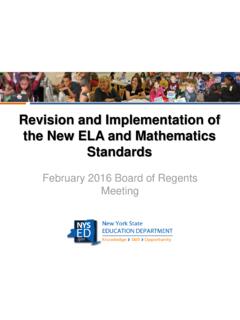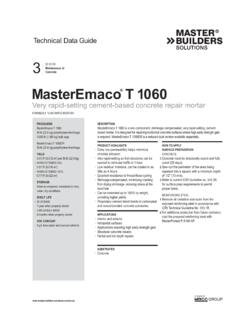Transcription of Professional Standards for Educational Leaders
1 Professional Standards for Educational Leaders Principal Preparation Project Advisory TeamBoard of RegentsDecember 12, 2017 Recap: DeliverablesOVERVIEW Consider stakeholder feedback collected during last 18 months Review proposed draft principles for cultural responsiveness Adoption of the Professional Standards for Educational Leaders (PSELs) the basis of principal prep and practice Recognize future steps in principal preparation planning sequence-ESSA funds for P-20 partnerships aimed at principal preparation-Encouraging districts to use some of their School Improvement Grant funds for mentoring, coaching and principal Professional development Review next phase of work 2 Recap: DeliverablesOverview and HistoryIn the last 12 months, presentations have been made to the NYS Board of Regents on the following 12, 2016-January 10, 2017-May 9, 2017-July 18, 2017-September 12, 20173 Adopt amendments proposed on September 12, 2017 that will effectively begin to shift the basis of principal preparation and practice to the 2015 Professional Standards for Educational STEPSWHAT SUPPORT EXISTS FOR UPDATING THE Standards (FROM 2008 TO 2015 VERSION)?
2 37-member Advisory Team reached consensus to update the groups joined in sending a letter May 20, 2016 urging Regents to adopt updated Standards :-Metropolitan Council for Educational Administration Programs (MCEAP) -Collegiate Association for Development of Educational Administration (CADEA) (& members) of organizations reviewed the PSELs and Advisory Team recommendations:-Deans at Independent Colleges and University that offer SBL programs-Empire State Supervisors and Administrators Association (ESSAA)-New York State United Teachers (NYSUT)-Ed School Deans at CUNY institutions offering SBL programs- Professional Standards and Practices Board at NYSED-Council for School Supervisors and Administrators (CSA)-School Administrators Association of New York State (SAANYS)-Rochester-based organizations (Urban League, Hillside Children s Center, Mayor s Office)-Metropolitan Council for Educational Administration Programs (MCEAP)-Collegiate Association for Development of Educational Administration (CADEA)-New York State Federation of School Administrators (NYSFSA)-New York State Council of School Superintendents (NYSCOSS)-New York State School Boards Association (NYSSBA)-Ed Schools Deans at SUNY institutions offering SBL programs -United Federation of Teachers (UFT)
3 -Chancellor of NYCDOE and Superintendents of Buffalo, Rochester, Syracuse, and Yonkers-Parent-Teacher Association (NYS PTA)4 NEXT STEPSA LOOK AT PSELsNational Policy Board for Educational Administration produced 2015 Professional Standards for Educational Leaders . There are 10 Standards (see Attachment C). Mission, Vision, and Core and Professional and Cultural , Instruction, and of Care and Support for Capacity of School Community for Teachers and Engagement of Families and and ImprovementNote: The three underlined items highlight areas where the PSEL Standards represent the greatest change from the 2008 Standards (that were created by the Interstate School Leaders Licensure Consortium, or ISLLC). Survey of the FieldFOLLOW UP ON REGENT REQUESTSAt the September 12, 2017, Board meeting the Regents made two requests of the formal public comment process, reach out to stakeholders in the field to gather face-to-face feedback on the proposed is cultural responsiveness, and what are guiding principles?
4 6 NEXT STEPSADDITIONAL DATES & LOCATIONS OF 11-STOP 26 Professional Standards and Practices Board 10 City College faculty, NYSFSA reps, 19 Metropolitan Council, Educational Admin 23 Hillside Center staff, principals, Mayor s office 25 Lehman College faculty, principals, 25 Brooklyn College faculty, principals, 2 SCSD principals/supervisors and higher 7 CSAreps, NYSFSArep, and NYCDOE 8 University at Buffalo faculty and school 13 SAANYS representatives and HollowNov. 21 ESSAA& CASreps and principals/supervisorsCSAis Council of School Supervisors and AdministratorsESSAAis Empire State Supervisors &Administrators AssociationCASis the Council of Administrators and SupervisorsSAANYSis School Administrators Association of New York StateNEXT STEPSTOUR PARTICIPANT COMPOSITION8115 Principals or APs41%72 Higher Ed Faculty26%27 District Admin11%26 Labor Reps9%16 Supts or DSs6%8 Teachers3%8 Community 3%3 HE Deans1%Fig. 1: Participant composition (n=275)NEXT STEPSFIVE BIG BUCKETS OF THEMES focus on equity and cultural timeline is realistic, but must be and implementation for Professional growth is P-20 Partnerships are needed to enhance and improve preparation9 NEXT STEPSBUCKET 1 -REPRESENTATIVE REMARKSBig Bucket #1A focus on equity and cultural responsiveness PSELs represent a welcome improvement.
5 In large part that is because of the emphasis on equity and cultural responsiveness. The PSELs are a step in the right direction because they put us in position to better prepare aspiring school building Leaders to meet the challenges of the job. The PSELs are moving in the right direction. They are moving us toward the kind of preparation that will equip [aspiring principals] to thrive in the conditions that exist in schools today. They aren t the whole story, but they help create a better talent pipeline because they focus on the right stuff. 10 NEXT STEPSBUCKET 2 -REPRESENTATIVE REMARKSBig Bucket #2 The timeline is realistic, but must be managed The date of 2020 is a realistic timeline for universities to adjust their principal preparation programs so they are organized around the 2015 Professional Standards for Educational Leaders . The deadline of 2022 is OK for the evaluation of principals using a rubric that is based on the Professional Standards for Educational Leaders .
6 11 NEXT STEPSBUCKET 3 -REPRESENTATIVE REMARKSBig Bucket #3 Alignment and implementation matters Alignment is the main idea. We need to know that the superintendent has a good understanding of PSELs. I want to be sure that the way I as a principal am evaluated is well understood by the superintendent and my supervisor. There is a lot to like about the PSELs. They re aligned to important things. As an administrator in a school that experienced the Comprehensive Diagnostic Need Assessment that NYSED conducts (that used the Diagnostic Tool for School and District Effectiveness), there should be alignment between the PSELs and these processes. Implementation is not a detail especially when it comes to a better internship With cultural diversity a reality, we need to infuse preparation with many points of view. What do competencies look like for principals and their supervisors. 12 NEXT STEPSBUCKET 4 -REPRESENTATIVE REMARKSBig Bucket #4 Support for Professional growth is vital What master do these new Standards serve?
7 If it is accountability, then they are just going to be perceived as leverage for discipline. Instead, I hope they exist to support the growth and development of educators. A vitally-important piece is the provision of coaching, not just for new principals but for all principals. Coaching and mentoring are vital here. In their university training, candidates may or may not have read a book [about a particular topic] but through coaching and mentoring they can learn what is needed here. 13 NEXT STEPSBUCKET 5 -REPRESENTATIVE REMARKSBig Bucket #5 Stronger P-20 Partnerships are needed to enhance and improve preparation. Everyone benefits when there is a healthy and sustained relationship between a university-based principal preparation program and a local school, school district, or schools (and school districts and sometimes BOCES). An ongoing dialogue can be focused on planning and modifying program offerings. It can be focused on identifying future talent and it can help ensure that the internship decisions that are made are productive.
8 14 NEXT STEPSCULTURAL RESPONSIVENESSIn broad terms, cultural responsiveness means creating instructional environments that propel learning by connecting new learning to each student s background and is a commitment to practices that help all students use landmarks of their own cultural background to build knowledge, skills, and an instructional standpoint, it means making content accessible by teaching in a way that students means using students personal interest as a basis for connecting content to student s personal do this, Educational Leaders must be able to relate aspects of students' daily lives to the Educational Leaders value students cultural and linguistic background then Educational Leaders (and the members of their school staff) see these as capital to build on, not barriers to student aim is to improve the learning experience by enhancing responsiveness advances and accelerates learning by honoring and supporting students cultural, linguistic, and racial *Sources: Ladson-Billings (2009 and 1994, p.)
9 382), K. Rajagopal, Create Success! (July 27, 2017), Aceves, Orosco(July 2014), CEEDAR Center and Gay (2010), Nieto, Bode, Kang, and Raible(2008)NEXT STEPSPRINCIPAL prep SEQUENCE: FUTURE PSELs are adopted, then develop competencies aligned to competencies into a rubric to guide Professional competencies into a rubric to guide principal ESSA funding for P-20 partnerships aimed at principal encouraging districts to use some of their School Improvement Grant funds for mentoring, coaching and principal Professional development16 NEXT STEPSCLOSING THOUGHTS We need Standards but not standardization. If we standardize around one approach a handful of people will fall through the cracks. The exact form of the partnership [that forms between a district and a university] will reflect the kind of community that is being served. What we need is Standards but enough flexibility in the system that we re responsive to community needs. I want to return to Standards and standardization.
10 I ask us all to think about and commit to making sure that we keep a clear focus on one thing. That is equity. Through the transition, will or how will these Standards and/or standardization impact equity? It is easy to say that implementation matters. What really matters today is that equity is advanced. 17 Recap: DeliverablesAKNOWLEDGEMENTP roposed changes considered today arise from a set of consensus recommendations produced by a 37-member Advisory Team. Thanks go to them and their co-chairs:-David Flatley (Carle Place School District Superintendent)-Helen Nell Scharf-Panero (Dir., Center for Educational Leadership, Baruch CollegeInput from Professional organizations was of organizations nominated Team members & helped arrange focus groupsoPrincipal groups (CSA, NYSFSA, CAS, SAANYS, ESSAA)oTeacher groups (NYSUT, UFT)oSuperintendent groups (NYSCOSS and the District Superintendents)oSchool Board group (NYSSBA)oState university Leaders (Office of Assistant Provost for Educational Leadership)oCity university Leaders (Office of University Provost)oCommission on Independent College and Universities (Office of the President)- Leaders and members of one particular organization lent their expertiseoThe Metropolitan Council for Educational Administration Programs18 Recap.)

















